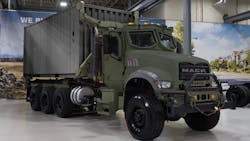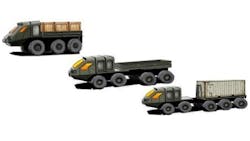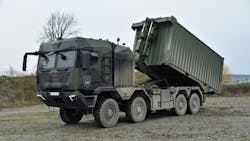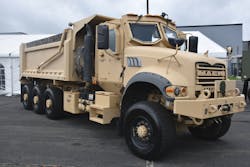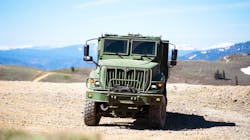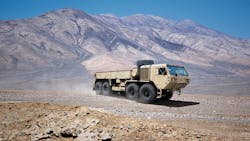Battle-tested CV builders to tackle next-gen Army transports
The U.S. Army has named four proven defense contractors—with close ties to commercial vehicle OEMs—to develop prototypes for the next generation of heavy transports, dubbed the Common Tactical Truck or CTT, which perform a wide range of combat logistics and support missions.
Mack Defense, Navistar Defense, Oshkosh Defense, and the American Rheinmetall Vehicles/GM Defense team will provide three prototypes of each variant for the CTT family of vehicles.
The initial “Other Transaction Authority” agreements, totaling $24.25 million, will fund the development of the M915 Line Haul Tractor and M1088 Medium Tractor; Palletized Load System (PLS); and Heavy Expanded Mobility Tactical Truck (HEMTT).
The aim of the multi-phased program is to replace the Army’s current family of heavy tactical trucks, with an initial production contract that could amount to some 7,000 trucks valued at more than $5.1 billion. Ultimately, production could total as many as 40,000 trucks valued at up to $14 billion.“The CTT effort brings an increased level of standardization to the Army’s Tactical Truck fleet. This effort is reminiscent of the original Liberty Truck, a heavy-duty truck produced by the United States Army during World War I,” said Program Executive Officer Combat Support & Combat Service Support (PEO CS&CSS) Brig. Gen. Samuel L. Peterson. “It was the first official standardized motor vehicle adopted and produced by the U.S. military. The CTT program can be viewed as the Liberty Truck of the 21st century, as it will similarly seek to streamline the Army’s supply, maintenance and training requirements.”
Specifically, the CTT family will replace the M915 Line Haul Tractor and M1088 Medium Tractor; PLS; and HEMTT. The contractors are tasked with leveraging best commercial practices, providing lower procurement cost (commercial economies of scale) and the latest technology. Vendors will also provide digital designs of all variants and a design study for a wrecker.
This rapid prototyping phase is meant to inform the Army as to whether commercially based variants can meet military requirements.
The CTT program is intended to redesign the fleet to integrate commercial technologies such as advanced driver assist systems, autonomy ready (foundation for future autonomy), fuel efficiency, exportable power as well as prognostics and predictive maintenance, according to Wolfgang Petermann, project manager, Transportation Systems, PEO CS&CSS.
“This approach allows the Army to modernize at the pace of industry, integrating new technologies as they are developed,” Petermann said. “Additionally, commonality in the CTT family of vehicles will enable open modular designs and interchangeable repair parts across the fleet, resulting in streamlined supply chains and reduced total lifecycle costs.”
The prototyping stage is designed to reveal commercial technologies and economies of scale that will enable the Army to close technological gaps and address the increasing age of the current Heavy Tactical Vehicle fleet.
Evaluation of the initial delivered prototypes is slated to commence in early 2024. Using the results from the program office’s prototype evaluation, a decision from the Army is expected in FY 2026.
The program office will then conduct a “full and open competition,” requiring offerors to deliver production-representative vehicles for run-off testing leading to a production contract.
ARV/GM
American Rheinmetall Vehicles and GM Defenseoffered the HX3 Common Tactical Truck (HX3-CTT). The HX3 is the latest generation of trucks in the combat-proven HX family of trucks which are in service with a number of NATO and U.S. allied nations.The HX family of trucks derives from MAN Truck and Bus commercial truck offerings, bringing commerciality to the fleet—a priority in the CTT program. Combined with the open architecture, the commercial backbone of the HX3-CTT will support persistent modernization and allow for rapid increases in capability as technologies mature, according to the manufacturer.
“Both American Rheinmetall Vehicles and GM Defense look forward to providing competition to the Army’s CTT Program,” said Matthew Warnick, Managing Director for American Rheinmetall Vehicles. “Together our team will deliver a transformational truck that leverages the commercial strengths of our partners, Rheinmetall MAN Military Vehicles and General Motors, and the commonality of the HX3-CTT design.”
The HX3-CTT features an advanced, interchangeable protected cab design, ADAS, and drive by wire operation. The new open systems electrical architecture allows rapid integration of leader-follower, tele-operation, and fully autonomous capabilities that focus on protecting troops.
See also: Leadership lessons from trucking’s military veterans
The HX3-CTT boasts commonality and modularity across variants: cargo, load handling systems, tankers, and line haul tractors. The HX family can scale from 4x4 to 10x10.
“Winning the CTT prototype phase demonstrates the undeniable value that the strategic collaboration between GM Defense and American Rheinmetall Vehicles brings to this important, next-generation Army program,” said Steve duMont, president of GM Defense. “We are excited to bring our advanced technologies and manufacturing prowess into this important collaboration and deliver a proven, modern solution to enhance warfighter capability.”
Mack
Mack Truckstraces its iconic corporate symbol, the bulldog, to anickname given to the Mack AC truckby troops on the battlefields of World War I.“We were confident in our ability to meet the needs outlined by the U.S. Army when we submitted our initial bid,” David Hartzell, president of Mack Defense, said in a statement. “Being chosen for the prototype phase of this program confirms that the Army recognizes Mack Defense has the experience in adapting our commercial based products, technologies, and global value chain needed to meet the strict requirements outlined for the CTT.”
Mack Defense is currently performing two major defense programs of record, each with a scope that directly aligns with the CTT. Both projects use modified, commercial-based vehicles from the extensive global Volvo Group network.
The first is the U.S. Army’s M917A3 Heavy Duty Dump Truck (HDT). The M917A3 HDT is based on the commercial Mack Granite model. Mack Defense was awarded the contract in 2018 after extensive testing and validation. Serial production began in 2021 and continues today in Allentown, PA.
The second active defense program is the Canadian Medium Support Vehicle System - Standard Military Pattern (MSVS-SMP). For the MSVS-SMP program, Mack Defense chose to use the Renault Kerax 8x8 truck, which was used to create 5 different logistics support vehicle platforms for the Canadian military. Mack Defense brought together expertise from the U.S., Canada, and France to successfully deliver 1,587 vehicles during a five-year production contract from June 2015 to June 2020 and is currently in the third year of a sustainment contract for the MSVS which includes parts, field service, maintenance, and repair.
Navistar
Navistar Defense's heritage traces back to the design, manufacturing, and logistics support of commercial trucks. This enables the company to combine the best of commercial and military capabilities, offering highly capable, cost-effective, low-risk solutions with a strong commercial lineage."As an industry leader in Militarized Commercial Off-the-Shelf vehicles, Navistar Defense is strongly positioned to meet the CTT program's mission goals of combining commerciality, commonality, and capability at the best value for the U.S. taxpayer," Navistar Defense CEO Ted Wright said. "Navistar Defense is uniquely capable of balancing the Army's force protection, survivability, and mission readiness requirements while leveraging the commercial industry's rapidly advancing technological capabilities.
"Our superior platforms are scalable to meet the vast majority of the Army's Tactical Wheeled Vehicles vehicle applications and mission roles for their medium and heavy fleets."
Oshkosh
Oshkosh Defensewill leverage its “battle-tested” Family of Heavy Tactical Vehicles (FHTV) platform for the CTT prototypes, ultimately providing a modernized version of the already capable FHTV. The FHTV’s flexible architecture allows it to support a multitude of missions with the ability to scale up or down with minimal change to the vehicle, according to the company.For decades, Oshkosh Defense has partnered with the U.S. Military to develop, test, and evolve advanced military and commercial technologies and integrate them onto the FHTV. The Oshkosh Defense CTT variants offer these technologies to achieve the U.S. Army’s desired capabilities of active safety, fuel demand reduction, autonomy, mission flexibility, prognostics, commonality, and superior survivability.
“As the U.S. Army’s premier provider of heavy, medium, and light tactical wheeled vehicle fleets, Oshkosh is uniquely qualified to inform the CTT requirements,” said Chief Programs Officer Pat Williams. “We look forward to partnering with the U.S. Army to refine their CTT desired capabilities and ensure our soldiers receive the capability they need and deserve.”
Oshkosh Defense designed six CTT variants, including a Load Handling System (LHS), Off-Road Tractor, Line Haul Tractor, Cargo, Wrecker, and Tanker.
Oshkosh Defense will also leverage the resources, expertise, and technologies of the entire Oshkosh Corporation family of companies and tailor them for stringent military applications.
“We’ve been the U.S. Army’s trusted provider of tactical wheeled vehicles for nearly 50 years. We understand the complexities of the battlefield and the demands that combat can impose on the vehicle fleet,” Williams continued. “That knowledge, combined with our engineering prowess positions us to provide the most capable and cost-effective CTT.”
This article originally appeared on FleetOwner.com.
